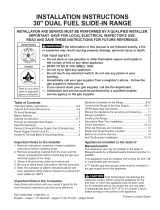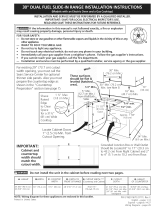
2
30" ELECTRIC SLIDE-IN RANGE INSTALLATION INSTRUCTIONS
• A child or adult can tip the range and
be killed.
• Verify the anti-tip device has been
installedtooororwallasper
installation instructions.
Tip Over Hazard
• Ensuretheanti-tipdeviceisre-engagedtoooror
wall when the range is moved.
• Do not operate the range without the anti-tip device
in place and engaged.
• Failure to follow these instructions can result in
death or serious burns to children and adults.
To check if the anti-tip bracket is installed
properly, use both arms and grasp
the rear edge of range back. Carefully
attempt to tilt range forward. When
properly installed, the range should not
tilt forward.
Refer to the anti-tip bracket installation instructions
supplied with your range for proper installation.
Cold temperatures can damage the
electronic control. When using the appliance for the
rsttime,orwhentheappliancehasnotbeenused
for an extended period of time, be certain the unit has
been in temperatures above 32°F (0°C) for at least 3
hours before turning on the power to the appliance.
• Be sure your range is installed and grounded
properly by a qualied installer or service
technician.
• This range must be electrically grounded in
accordance with local codes or, in their absence,
with the National Electrical Code ANSI/NFPA No.
70—latest edition in United States or with CSA
Standard C22.1, Canadian Electrical Code, Part 1
in Canada.
• Theinstallationofappliancesdesignedfor
manufactured (mobile) home installation must conform
with Manufactured Home Construction and Safety
Standard, title 24CFR, part 3280 [Formerly the Federal
Standard for Mobile Home Construction and Safety,
title 24, HUD (part 280)] or when such standard
is not applicable, the Standard for Manufactured
Home Installation 1982 (Manufactured Home Sites,
Communities and Setups), ANSI Z225.1/NFPA
501A-latest edition, or with local codes in United States
and with CAN/CSA-Z240 MH in Canada.
• Make sure the wall coverings around the range
can withstand the heat generated by the range.
• Before installing the range in an area covered with
linoleum or any other synthetic oor covering,
make sure the oor covering can withstand heat
at least 90°F (32,2°C) above room temperature
without shrinking, warping or discoloring. Do not
install the range over carpeting unless you place an
insulating pad or sheet of ¼" (0,64 cm) thick plywood
between the range and carpeting.
Never leave children alone or
unattended in the area where an appliance is in
use. As children grow, teach them the proper, safe
use of all appliances. Never leave the oven door open
when the range is unattended.
Stepping, leaning or sitting on the
door or drawer of this range can result in serious
injuries and can also cause damage to the range.
• Do not store items of interest to children in
the cabinets above the range. Children could be
seriously burned climbing on the range to reach items.
• To eliminate the risk of burns or re by reaching
over heated surface units, cabinet storage space
above the surface unit should be avoided. If
cabinet storage is to be provided the risk can be
reduce by installing a range hood that projects
horizontally a minimum of 5 inches beyond the
bottom of the cabinet.
• Do not use the oven as a storage space. This
creates a potentially hazardous situation.
• Never use your range for warming or heating the
room. Prolonged use of the range without adequate
ventilation can be dangerous.
• Do not store or use gasoline or other ammable
vapors and liquids near this or any other
appliance. Explosionsorrescouldresult.
• Reset all controls to the "off" position after using
a programmable timing operation.
This manual contains important safety symbols and instructions. Please pay attention to these symbols and
follow all instructions given.
This symbol will help alert you to situations that may cause serious bodily harm, death or
property damage.
This symbol will help alert you to situations that may cause bodily injury or property
damage.
IMPORTANT SAFETY INSTRUCTIONS















